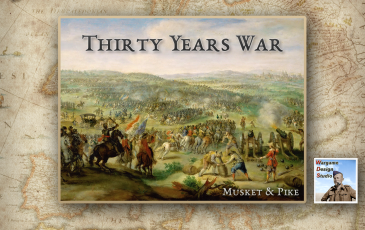030_The Battle of Lutter - Variant - WDS Thirty Years War

64f8a9520a0c004fd5ef.jpg) 0 - 0 - 0
0 - 0 - 0
435be480296def0cb8f9.jpg)
| Rating: | 0 (0) |
| Games Played: | 0 |
| SM: | 1 |
| Turns: | 16 |
| Type: | Stock |
| First Side: | Anti-Imperialist (TYW) |
| Second Side: | Imperialist (TYW) |
Date: 27th August 1626 - Size: Medium - Location: Lutter, Lower Saxony
Scenario Briefing: The Battle of Lutter - Christian IV of Denmark, a moderate Lutheran who feared Catholicism yet hated the extreme version of Protestantism represented by Calvinism, had initially avoided involvement in the German conflict, despite his German possessions and eagerness to contest the Hapsburg emperor's political power in northern Germany. Christian's hostility to neighboring Protestant Sweden and Holland and friendship with Catholic Spain complicated his position. It was only when England and Holland formed an anti-Hapsburg alliance - the Treaty of The Hague - in December 1625 and promised financial support for Danish intervention that Christian decided to get involved. Lacking a standing army, and with the Danish Council of State refusing to declare war of the Hapsburg emperor, Christian had difficulty raising an adequate army. Consequently, the 1626 campaign plan relied on Christian's own army of some 21,000 men receiving support from Mansfeld and the German leaders Christian of Brunswick and Maurice of Hesse-Kassel.
Mansfeld's defeat at Dessau Bridge in April and the death of Brunswick in June left Christian unsupported and he decided to fall back to his base at Wolfenbuttel. Bad weather and a slow baggage train allowed the veteran Imperialist general Tilly with a slightly smaller but more experienced army to catch up with Christian and force him to give battle at Lutter. Dividing his army into three echelons - and assuming direct control of one of these himself - Christian hoped the marsh stream separating his forces from the enemy would enable him to avoid a full scale battle and just fight a rearguard action until his army could get away safely. Meanwhile, Tilly decided to risk weakening his center in order to secure the bridge at Rohde and outflank Christian on both flanks.
This variant is included due to wide discrepancies in the details of this battle from various sources. This version uses the "Wilson" information as its primary source, while the "a" version uses "Guthrie" as the primary source.
Recommended Rules: Default
Note: Suitable for playing either side against the A/I and also for Head-to-Head.
Scenario Briefing: The Battle of Lutter - Christian IV of Denmark, a moderate Lutheran who feared Catholicism yet hated the extreme version of Protestantism represented by Calvinism, had initially avoided involvement in the German conflict, despite his German possessions and eagerness to contest the Hapsburg emperor's political power in northern Germany. Christian's hostility to neighboring Protestant Sweden and Holland and friendship with Catholic Spain complicated his position. It was only when England and Holland formed an anti-Hapsburg alliance - the Treaty of The Hague - in December 1625 and promised financial support for Danish intervention that Christian decided to get involved. Lacking a standing army, and with the Danish Council of State refusing to declare war of the Hapsburg emperor, Christian had difficulty raising an adequate army. Consequently, the 1626 campaign plan relied on Christian's own army of some 21,000 men receiving support from Mansfeld and the German leaders Christian of Brunswick and Maurice of Hesse-Kassel.
Mansfeld's defeat at Dessau Bridge in April and the death of Brunswick in June left Christian unsupported and he decided to fall back to his base at Wolfenbuttel. Bad weather and a slow baggage train allowed the veteran Imperialist general Tilly with a slightly smaller but more experienced army to catch up with Christian and force him to give battle at Lutter. Dividing his army into three echelons - and assuming direct control of one of these himself - Christian hoped the marsh stream separating his forces from the enemy would enable him to avoid a full scale battle and just fight a rearguard action until his army could get away safely. Meanwhile, Tilly decided to risk weakening his center in order to secure the bridge at Rohde and outflank Christian on both flanks.
This variant is included due to wide discrepancies in the details of this battle from various sources. This version uses the "Wilson" information as its primary source, while the "a" version uses "Guthrie" as the primary source.
Recommended Rules: Default
Note: Suitable for playing either side against the A/I and also for Head-to-Head.





















